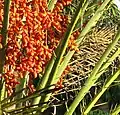Phoenix sylvestris
Phoenix sylvestris (sylvestris - Latin, of the forest) also known as silver date palm, Indian date, sugar date palm or wild date palm,[2] is a species of flowering plant in the palm family native to southern Pakistan, most of India, Sri Lanka, Nepal, Bhutan, Myanmar and Bangladesh. It is also reportedly naturalized in Mauritius, the Chagos Archipelago, Puerto Rico and the Leeward Islands.[1] Growing in plains and scrubland up to 1300 m above sea level, the fruit from this palm species is used to make wine and jelly. The sap is tapped and drunk fresh or fermented into toddy. The fresh sap is boiled to make palm jaggery in West Bengal state of India and Bangladesh.

| Phoenix sylvestris | |
|---|---|
_tree_at_Purbasthali_W_IMG_1494.jpg.webp) | |
| In West Bengal, India | |
| Scientific classification | |
| Kingdom: | Plantae |
| Clade: | Tracheophytes |
| Clade: | Angiosperms |
| Clade: | Monocots |
| Clade: | Commelinids |
| Order: | Arecales |
| Family: | Arecaceae |
| Genus: | Phoenix |
| Species: | P. sylvestris |
| Binomial name | |
| Phoenix sylvestris | |
| Synonyms[1] | |
| |
Description
Phoenix sylvestris ranges from 4 to 15 m in height and 40 cm in diameter; not as large as the Canary Island Date Palm, but nearly so, and resembling it. The leaves are 3 m long, gently recurved, on 1 m petioles with acanthophylls near the base. The leaf crown grows to 10 m wide and 7.5 to 10 m tall containing up to 100 leaves. The inflorescence grows to 1 metre with white, unisexual flowers forming to a large, pendent infructescence. The single-seeded fruit ripens to a purple-red colour.[3]
Information
- Origin: India
- Hardiness Zone: 8B-11
- Growth Rate: Slow to moderate
- Survival Temperature: 22 °F/-5.5 °C
- Salt Tolerance: Moderate to high
- Drought Tolerance: High
- Soil Requirements: Widely adaptable
- Light Requirements: High
- Nutritional Requirements: Moderate
- Uses: Specimen tree
- Major Pest Problems: None
- Trunk or Stem Characteristics: Robust, with diamond a skirt of aerial roots at base and persistent leaf bases above.
- Leaf Type: Pinnately compound, induplicate; lower leaflets modified into spines; 200 - 250 leaflets arranged in groups of 2 or 3, often cross-crossing. Canopy of 100 leaves 9–12 feet long.
- Foliage Color: Blue-green Leaf Size: 9-12’ long; leaflets .5-1.5’ long, 1" wide Petiole: 3’ long, armed with leaflets spines.
- Crown-shaft: None
- Inflorescence: 2-3" long, much branched, borne from among the leaves
- Gender: Separate male and female plants
- Tree Height: Usually up to 40 feet[4]
- Sun Exposure: Full Sun
- Danger: Plant has spines or sharp edges; use extreme caution when handling
- Bloom time: Late Spring/Early Summer
- Bloom color: Cream/Tan
- Propagation Methods: From seed; germinate in a damp paper towel & From seed; germinate in vitro in gelatin, agar or other medium
- Seed collecting: Remove fleshy coating on seeds before storing
Properly cleaned, seed can be successfully stored
- Soil pH requirements: 6.1 to 6.5 (mildly acidic) ;6.6 to 7.5 (neutral) ;7.6 to 7.8 (mildly alkaline)
Gallery
 Growing in Englewood Florida
Growing in Englewood Florida_female_flowers_at_Narendrapur_W_IMG_4056.jpg.webp)
_male_flowers_at_Narendrapur_W_IMG_4059.jpg.webp)
 Mature specimens, Ft Myers, Florida
Mature specimens, Ft Myers, Florida Fruits and spines in the Yucatán, Mexico
Fruits and spines in the Yucatán, Mexico Growing on Saint Simons Island in Georgia USA
Growing on Saint Simons Island in Georgia USA-_lower_trunk_at_Purbasthali_W_IMG_1660.jpg.webp)
 Fruits in Karnataka, India
Fruits in Karnataka, India Palm sugar from Kerala (India) – traditional cottage industry
Palm sugar from Kerala (India) – traditional cottage industry.jpg.webp) Fruits in Sri Lanka
Fruits in Sri Lanka
References
- "Phoenix sylvestris". World Checklist of Selected Plant Families (WCSP). Royal Botanic Gardens, Kew. Retrieved 10 January 2017.
- "Phoenix sylvestris". Germplasm Resources Information Network (GRIN). Agricultural Research Service (ARS), United States Department of Agriculture (USDA). Retrieved 10 January 2017.
- Riffle, Robert L. and Craft, Paul (2003) An Encyclopedia of Cultivated Palms. Portland: Timber Press. (Pages 405-406) ISBN 0-88192-558-6 / ISBN 978-0-88192-558-6
- http://www.phoenixsylvestris.com/photo-gallery.php
External links
| Wikimedia Commons has media related to Phoenix sylvestris. |
